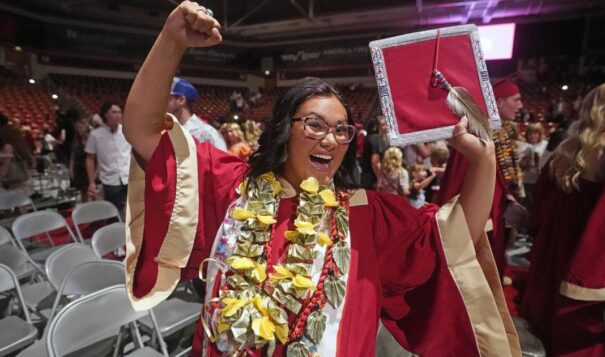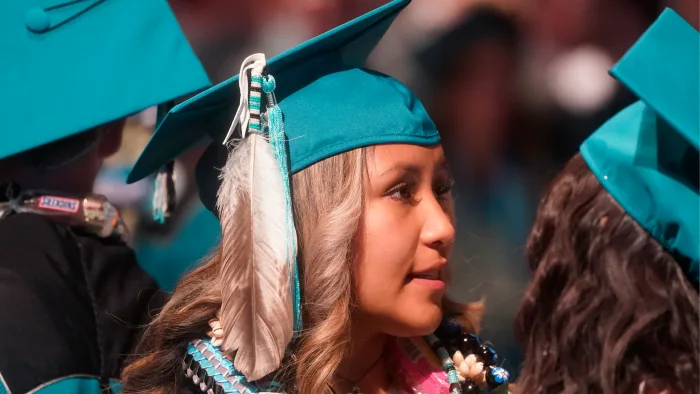News Based on facts, either observed and verified directly by the reporter, or reported and verified from knowledgeable sources.
Native students seek acceptance of tribal regalia
 Amryn Tom reacts after graduating from Cedar City High School on Wednesday, May 25, 2022, in Cedar City, Utah. Tom is wearing an eagle feather given to her by her mother and a cap that a family friend beaded. (AP Photo/Rick Bowmer)
Amryn Tom reacts after graduating from Cedar City High School on Wednesday, May 25, 2022, in Cedar City, Utah. Tom is wearing an eagle feather given to her by her mother and a cap that a family friend beaded. (AP Photo/Rick Bowmer)
Disputes over such attire have spurred laws making it illegal to prevent Native students from wearing regalia in nearly a dozen states
When Kamryn Yanchick graduated, she hoped to decorate her cap with a beaded pattern in honor of her Native American heritage. Whether she could was up to her Oklahoma high school. Administrators told her no.
Yanchick settled for wearing beaded earrings to her 2018 graduation.
A bill vetoed earlier this month by Oklahoma Gov. Kevin Stitt, a Republican, would have allowed public school students to wear feathers, beaded caps, stoles or other objects of cultural and religious significance. Yanchick, a citizen of the Seminole Nation of Oklahoma and descendent of the Muscogee Nation, said she hopes the legislature tries again.
Being able to “unapologetically express yourself and take pride in your culture at a celebration without having to ask a non-Native person for permission to do so is really significant,” said Yanchick, a Native American policy advocate and a former intern with the American Civil Liberties Union of Oklahoma.
For Native students, tribal regalia is often passed down through generations and worn at graduations to signify connection with the community. Disputes over such attire have spurred laws making it illegal to prevent Native American students from wearing regalia in nearly a dozen states including Arizona, Oregon, South Dakota, North Dakota and Washington.
High schools, which often favor uniformity at commencement ceremonies, take a range of approaches toward policing sashes, flower leis and other forms of self-expression. Advocates argue the laws are needed to avoid leaving it up to individual administrators.
Groups like the Native American Rights Fund hear regularly from students blocked from wearing eagle feathers or other regalia. This week in Oklahoma, a Native American high school graduate sued a school district, claiming she was forced her to remove a feather from her cap at a ceremony last spring.
When Jade Roberson graduated from Edmond Santa Fe High School, the same school attended by Yanchick, she would have liked to wear a beaded cap and a large turquoise necklace above her gown. But it didn’t seem worth asking. She said a friend was only able to wear an eagle feather because he spoke with several counselors, consulted the principal and received a letter from the Cherokee Nation on the feather’s significance.
“It was such a hassle for him that my friends and I decided to just wear things under our gown,” said Roberson, who is of Navajo descent. “I think it is such a metaphor for what it is like to be Native.”

When Adriana Redbird graduates this week from Sovereign Community School, a charter school in Oklahoma City that allows regalia, she plans to wear a beaded cap and feather given by her father to signify her achievements.
“To pay tribute and take a small part of our culture and bring that with us on graduation day is meaningful,” she said.
In his veto message, Stitt said allowing students to wear tribal regalia should be up to individual districts. He said the proposal could also lead other groups to “demand special favor to wear whatever they please” at graduations.
The bill’s author, Republican state Rep. Trey Caldwell, represents a district in southwest Oklahoma that includes ancestral land of Kiowa, Apache and Comanche.
“It’s just the right thing to do, especially with so much of Native American culture so centered around right of passage, becoming a man, becoming an adult,” he said.
Several tribal nations have called for an override of the veto. Cherokee Nation Principal Chief Chuck Hoskin Jr. said the bill would have helped foster a sense of pride among Native American students. Muscogee Nation Principal Chief David Hill said students who “choose to express the culture and heritage of their respective Nations” are honoring their identity.
It means a lot that the bill was able to garner support and make it to the governor, Yanchick said, but she wishes it wasn’t so controversial.
“Native American students shouldn’t have to be forced to be activists to express themselves or feel celebrated,” she said.
